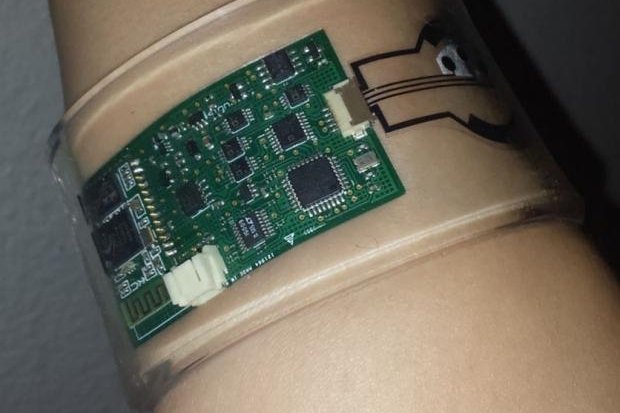A wearable device that extracts sweat and analyzes its makeup to monitor health and disease was developed by researchers at Stanford University School of Medicine. Photo by Sam Emaminejad/Stanford School of Medicine
April 20 (UPI) -- Stanford University researchers have created a wearable sensor that is capable of diagnosing diseases such as cystic fibrosis by measuring and analyzing sweat.
The wristband-style wearable sweat sensor diagnoses diseases by measuring the molecular makeup of sweat such as chloride ions and glucose levels.
The sensor collects sweat and measures its molecular composition and then electronically transmits the results for analysis and diagnostics for diseases like cystic fibrosis, diabetes and other diseases.
Researchers at the Stanford University School of Medicine collaborated with researchers at the University of California Berkeley to develop the wearable sensor.
The sensor is a two-part system of flexible sensors and microprocessors that adheres to the skin, stimulates the sweat glands and detects the presence of different molecules and ions based on their electrical signals. The more chloride in the sweat, the more electrical voltage is generated.
High levels of chloride ions are an indicator of cystic fibrosis and high levels of blood glucose can indicate diabetes.
Cystic fibrosis is a genetic disease that causes mucus to build up in the lungs, pancreas and other organs and diagnosis requires patients go to a specialized center and have electrodes stimulating sweat glands in their skin to provide sweat for the test. This can be invasive, especially for children.
According to Dr. Carlos Milla, associate professor of pediatrics at Stanford, the conventional method in diagnosing cystic fibrosis has remained unchanged for 70 years.
The wearable sweat sensor stimulates the skin to produce minute amounts of sweat, quickly evaluating the contents of the sweat and sending the data via a cellphone to a server that can analyze the results.
The sensor could also be used in underserved communities or remote villages in developing countries where conventional testing is unavailable.
"It's a little like the old days when people with diabetes had to come into a clinic to get their glucose monitored," Milla said. "The real revolution came when people started to do their own finger stick, and nowadays you can even do it with continuous monitors."
The research, which is published in the Proceedings of the National Academy of Sciences, is part of Stanford Medicine's focus on precision health.















